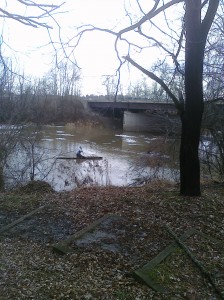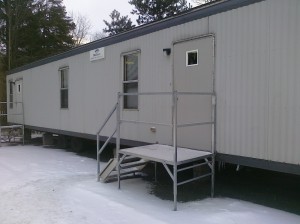Jim and I snuck out this afternoon for a paddle. It had been snowing pretty hard this morning, and I envied Dan and Stephen who were going skiing, but by the afternoon it had warmed up to the mid thirties and was raining off and on. I was nearly ready to knock off for the day when I got a text message from Jim inviting me to paddle. I can never say no to Jim, so I loaded up the Looksha and headed out to the river.
The river had dropped quite a bit – you could see a shelf of ice about a foot or more up from the current water levels. That made finding a place to put in a bit difficult. But at least the river wasn’t full of ice floes this time. It was still running fast, though. We paddled up stream using every trick to try to stay out of the main current, but barely managed about 4.4 mph the whole way up. Because I was in the Looksha, I could be a lot more daring in terms of cutting between debris in the river, both because the boat is stable and strong as a tank, and also because it has a kick-up rudder so a submerged trunk won’t knock the rudder off the boat or knock me out of the boat. Jim and I were able to experiment with a few tricks where we could see where sneaking in close to shore could gain you a couple of boat lengths on somebody taking a safer route out in the current.
Coming back was a different story – we hung out in the middle of the stream to get full advantage of it, and averaged about 7.4 mph or so. The big advantage of coming back is that because there is no advantage to getting in close to shore, we could paddle side by side and talk more.
One seemingly contradictory thing about this Looksha is that while it’s a big wide stable tank, it’s actually a tight squeeze getting in and out. The seat has side pieces that hold me in pretty tight when I’m wearing cold weather clothing, and the cockpit is much shorter front to back so I can’t draw my knees up. Getting out on a steep bank where I couldn’t use a paddle brace was pretty undignified looking, and I got kind of muddy, but at least I only got one foot soaked in freezing cold water.
Bottom line? Last year, my last paddle of the season was the Saturday after Thanksgiving. This year, I’m paddling the day before New Years. It doesn’t get any better than this.


